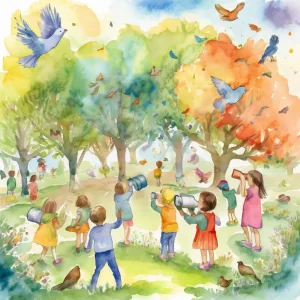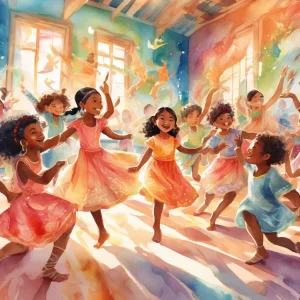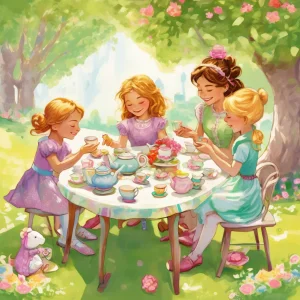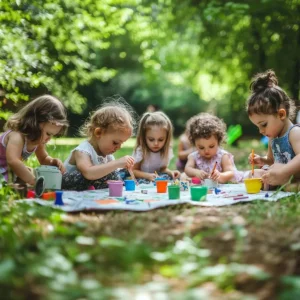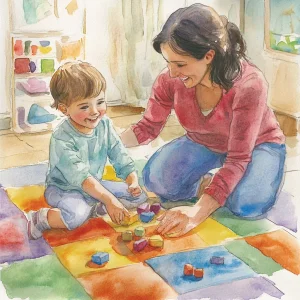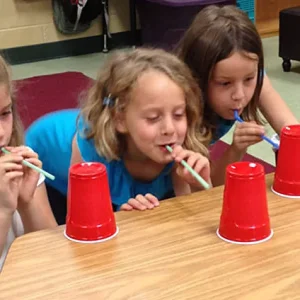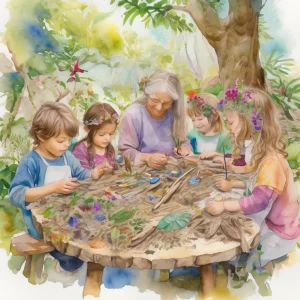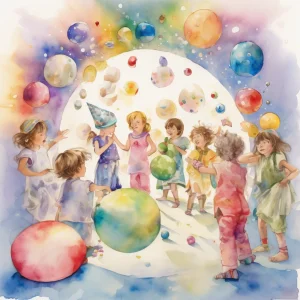Activity
Similar Activities
Enchanted Sound Symphony: Sensory Sound Walk
Children’s Age: 2 months – 3 years
Activity Duration: 5 – 25 minutes
Exploring sounds and textures through a sensory walk outdoors.
Activity Duration: 5 – 25 minutes
Picnic Adventure: Pretend Cooking Play for Toddlers
Children’s Age: 2–3 years
Activity Duration: 10 – 30 minutes
An imaginative activity where children (ages 2-3) engage in pretend cooking during a picnic adventure.
Activity Duration: 10 – 30 minutes
Nature Shapes Adventure: Bird Watch & Scavenger Hunt
Children’s Age: 4–5 years
Activity Duration: 10 minutes
An outdoor activity for children aged 4-5 years combining bird watching and shape recognition.
Activity Duration: 10 minutes
Musical Freeze Painting: A Creative Dance Adventure
Children’s Age: 3 years
Activity Duration: 10 – 20 minutes
An engaging activity combining painting with musical freeze dance to promote creativity and play skills.
Activity Duration: 10 – 20 minutes
Enchanted Tea Party Adventure: A Magical Journey
Children’s Age: 3 years
Activity Duration: 10 – 15 minutes
Join us for a Magical Tea Party Adventure! Enhance your child's play skills, social-emotional growth, and language abilities through a whimsical tea party experience. Gather teacup…
Activity Duration: 10 – 15 minutes
Outdoor Tea Party and Fix-it Fun for Toddlers
Children’s Age: 2–4 years
Activity Duration: 10 – 25 minutes
Let's create a fun Outdoor Tea Party and Fix-it Station for kids aged 1 to 3. Set up a table and chairs, play tea set, pretend tools, household items for fixing, a picnic blanket, …
Activity Duration: 10 – 25 minutes
Unity Blossoms: Family Handprint Tree
Children’s Age: 0 month – 6 years
Activity Duration: 10 minutes
Let's create a special "Family Handprint Tree" together! This fun activity brings families closer and helps kids grow in many ways. You'll need paper, colorful paints, brushes, wet…
Activity Duration: 10 minutes
Colorful Objects Sorting Game for Cognitive Development
Children’s Age: 1.5–4 years
Activity Duration: 10 – 15 minutes
This colorful sorting game is designed to boost your child's cognitive skills and nurture their curiosity. Gather safe, colorful objects like blocks or toys from your home. Place t…
Activity Duration: 10 – 15 minutes
Whimsical Cup Blow Race for Kids
Children’s Age: 4–6 years
Activity Duration: 5 – 10 minutes
The Cup Race Challenge activity is designed to boost teamwork, fine motor skills, and problem-solving in children. You'll need plastic cups, straws, a table, and masking tape to cr…
Activity Duration: 5 – 10 minutes
Enchanted Coding Adventure Storytelling with Imagination
Children’s Age: 10–12 years
Activity Duration: 45 minutes
The "Coding Adventure Storytelling" activity is tailored for children aged 10-12 to enhance empathy, play skills, language abilities, and introduce basic programming concepts in a …
Activity Duration: 45 minutes
Enchanted Garden: Nature Sculpture Garden Adventure
Children’s Age: 4–6 years
Activity Duration: 10 – 25 minutes
Engage children aged 48 to 72 months in the "Nature Sculpture Garden" activity, promoting creativity and empathy. Using natural materials like sticks and leaves, along with clay an…
Activity Duration: 10 – 25 minutes
Imaginary Adventures: Mini Bowling Feelings Story Game
Children’s Age: 2–5 years
Activity Duration: 10 minutes
An engaging activity promoting sensory development, creativity, reading, and storytelling.
Activity Duration: 10 minutes







